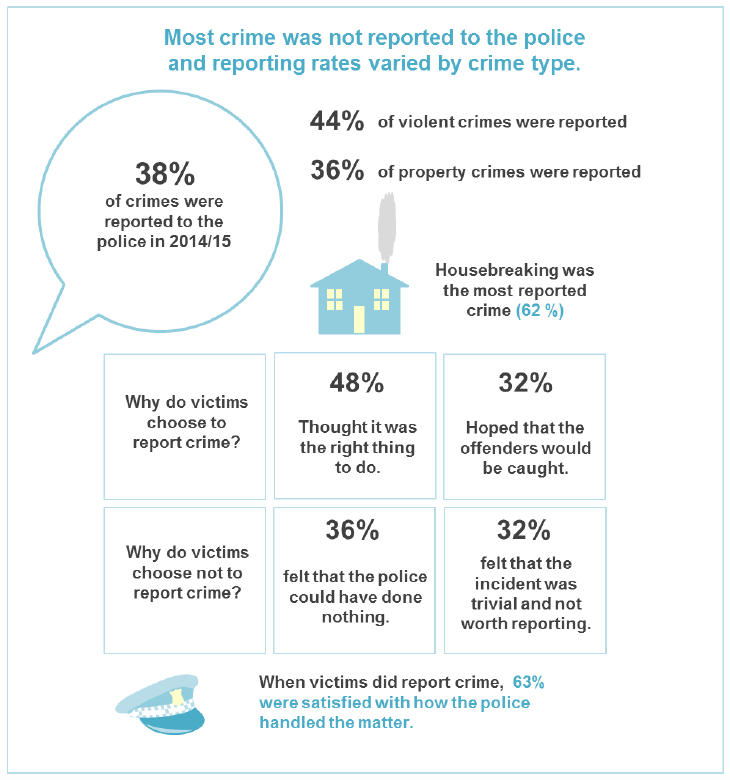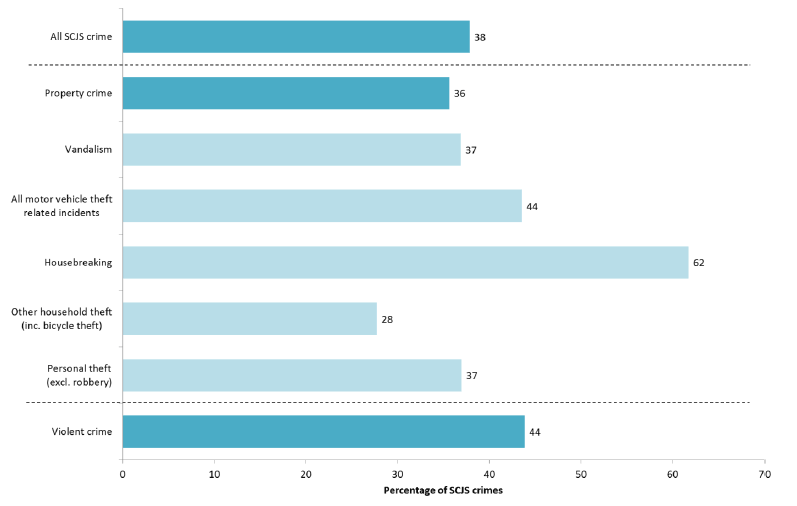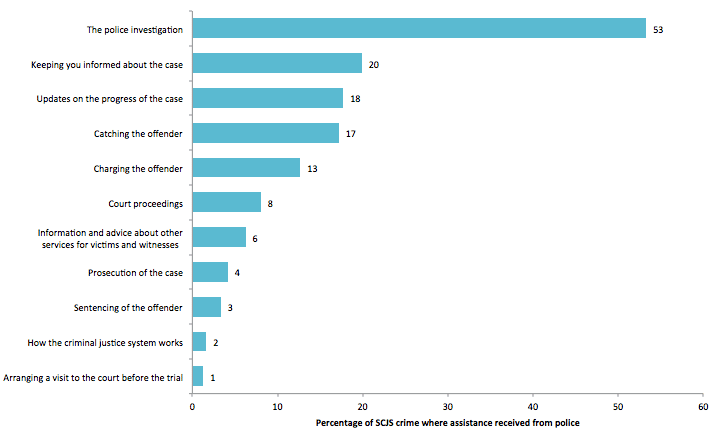Scottish Crime and Justice Survey 2014/15: Main Findings
Main findings from the Scottish Crime and Justice Survey 2014/15.
6. Reporting Crime and Support for Victims

6.1. Introduction
Victims of crime are also asked whether the police came to know about the incident, the reasons for choosing to report or not report, the police response and about a range of support available to victims.
6.2. Reporting Crime to the Police
The 2014/15 SCJS estimates that 38% of crimes were reported to the police[24]. This level of reporting has been fairly consistent in recent years (for example, 39% in 2012/13). As shown in Figure 6.1, reporting levels vary by crime group, with, for example, 44% of violent crime reported to the police, compared to 36% of property crimes. Reporting rates were highest for housebreaking (62%).
Figure 6.1 Percentage of crime that was reported to the police (SCJS 2014/15)

Base: All SCJS crime (1,930); Property crime (1,640); Vandalism (600); All motor vehicle theft (170); Housebreaking (90); Other household theft (inc. bicycle theft) (570); Personal theft (excl. robbery) (220); Violent crime (280)
Deciding whether or not to report crime to the police can be influenced by many factors. For example, just under half (48%) of victims who thought that the incident was a crime reported it to the police, compared to 18% who thought it was wrong, but not a crime and 19% of those who thought it was just something that happens.
In property crime, whether the stolen or damaged items were insured had an impact on whether the victim chose to report the crime. The reporting rate for insured property that is stolen or damaged is 44%, compared to 30% for uninsured property which is stolen or damaged.
6.2.1. Why Crime Wasn't Reported
The police did not come to know about 62% of the crime measured by the SCJS. Table 6.1 provides an overview of the reasons victims gave for not reporting crime, broken down by crime group. Overall, the most common reasons were that the victim felt that the police could not have done anything (36%) or that the incident was too trivial or not worth reporting (32%).
Table 6.1 Most common reasons given for not reporting crime (SCJS 2014/15)
| Percentage of SCJS crimes | Unreported property crime | Unreported violent crime | All unreported crime |
|---|---|---|---|
| Police could not have done anything about it | 42 | 15 | 36 |
| Incident was too trivial, not worth reporting | 37 | 16 | 32 |
| Victims dealt with the matter themselves | 9 | 22 | 12 |
| Police would not have been interested | 14 | 6 | 12 |
| Inconvenient / too much bother to report | 7 | 6 | 7 |
| Incident was considered a personal or family matter | 3 | 18 | 7 |
| Crime was reported to other authorities or organisations | 5 | 10 | 6 |
| Previous bad experience of the police or courts | 2 | 5 | 3 |
| Dislike / fear of the police | 1 | 6 | 2 |
| Fear of reprisals by offenders | 2 | 4 | 2 |
| There was no loss or damage | 2 | 2 | 2 |
| Number of Respondents | 1,020 | 150 | 1,170 |
Variable names: QPON
There was some variation in the reasons given between victims of violent crime and property crime. For example, victims of violent crime were more likely to choose not to report because the incident was considered to be a personal or family matter (18%), compared to victims of property crime victims (3%). Likewise, victims of violent crime were more likely to deal with the matter themselves (22%), compared to 9% or property crime victims. In such cases of violent crime, where victims said that they would deal with the matter themselves, most commonly the victim spoke to the person involved (69%), spoke to friends and family of the person involved (12%), and in a minority of cases they threatened violence/reprisal (7%).
Victims of property crime were more likely to think that the police could have done nothing (42%), compared to 15% of victims of violent crime.
6.2.2. Why Crime Was Reported
When victims decided to report crime to the police, they were asked to provide reasons why. Table 6.2 provides an overview of the reasons given. Respondents most commonly said they reported the crime as they thought that all crimes should be reported as a duty or it was considered to be the right thing to do (48%) and in the hope that the offenders would be caught or punished (32%).
There was some variation in the reasons given for reporting crime between victims of violent crime and victims of property crime. For example, victims of property crime were more likely to report crime because they felt that it was 'the right thing to do' (55%), than victims of violent crime (30%). However, victims of violent crime were more likely than victims of property crime to report crime because it was serious or upsetting (44% compared to 12%).
Table 6.2 Most common reasons for reporting crime (SCJS 2014/15)
| Percentage of SCJS crimes where the police were told by respondent / person in household / other person | Reported property crime | Reported violent crime | All reported crime |
|---|---|---|---|
| All crimes should be reported / right thing to do / duty / automatic | 55 | 30 | 48 |
| In the hope that offenders would be caught / punished | 30 | 37 | 32 |
| The crime was serious or upsetting | 12 | 44 | 21 |
| Hoped to avoid repetition of crime to someone else | 16 | 21 | 18 |
| In the hope that property would be recovered | 23 | - | 17 |
| Hoped to avoid repetition of crime to oneself | 16 | 16 | 16 |
| Needed a crime number for purposes of insurance claim | 20 | 1 | 15 |
| To satisfy other authorities | 4 | 2 | 3 |
| Needed assistance (e.g. to get home) | 1 | 7 | 3 |
| Someone else reported the crime | 1 | 4 | 2 |
| Police witnessed the crime | 1 | 3 | 1 |
| Number of Respondents | 590 | 110 | 700 |
Variable names: QPKR
6.3. Satisfaction with Police Response
Among victims of crime, 62% said overall the police dealt with case fairly while 20% disagreed (and 9% neither agreed or disagreed and a further 6% said not applicable as they had no dealings with the police). Further to this, 83% of the victims agreed the police gave them an opportunity to fully explain what happened, while 9% disagreed. Just under half (48%) of victims agreed that the police gave them an opportunity to express their view about how the case should be handled, while 25% disagreed. Around three-quarters (74%) of victims agreed that the police dealt with them fairly, while 17% disagreed.
Victims of crime were asked about their views on how the police dealt with the matter. Overall, in 2014/15, 63% were very or quite satisfied with how the police handled the matter, 9% were neither satisfied or dissatisfied and 26% were very or quite dissatisfied. Victims were more likely to be (very or fairly) satisfied if they had face-to-face contact with the police (68%), compared with those who did not have face-to-face contact (50%). Although the equivalent result for 2014/15 in England and Wales is not yet available, the 2013/14 CSEW showed that victims in 74% of incidents were 'very' or 'fairly' satisfied with how the police handled the matter[25].
There are a number of different sources of information or assistance available to victims of crime, including police liaison officers, police sources, Victim Support Scotland and the Witness Service. Table 6.3 gives an overview of the organisations that provided information or assistance. For both victims of property crime and violent crime, the police was the most common organisation to provide support (42% and 43% respectively).
Table 6.3 Whether information or assistance was received about the investigation/case (SCJS 2014/15)
| Percentage of SCJS crimes | Reported property crime | Reported violent crime | All reported crime |
|---|---|---|---|
| Any organisation | 47 | 51 | 48 |
| Police | 42 | 43 | 42 |
| Victim Support Scotland / Witness Service | 8 | 16 | 10 |
| Procurator Fiscal’s Office | 1 | 8 | 3 |
| Did not receive any information | 22 | 21 | 22 |
| The case was not investigated | 24 | 21 | 23 |
| Number of Respondents | 610 | 130 | 740 |
Variable names: QINF
The survey also asked victims about the type of information and assistance provided by police. Figure 6.2 provides an overview of this and shows that, where information or assistance was provided, this was mostly about the police investigation.
Figure 6.2 Information or assistance provided to victims by the police (SCJS 2014/15)

Base: All SCJS crime where information or assistance received from the police (350)
Variable name: QINTY
Contact
Email: Trish Brady-Campbell
There is a problem
Thanks for your feedback